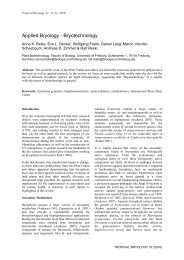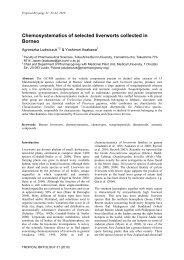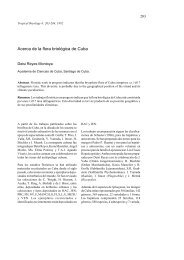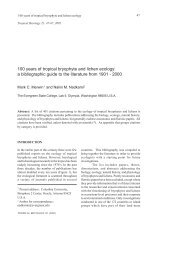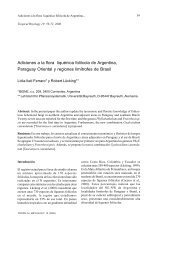Checklist of the mosses of sub-Saharan Africa
Checklist of the mosses of sub-Saharan Africa
Checklist of the mosses of sub-Saharan Africa
Create successful ePaper yourself
Turn your PDF publications into a flip-book with our unique Google optimized e-Paper software.
94<br />
from references published since <strong>the</strong> original<br />
country lists.<br />
- Where <strong>the</strong> source information does not<br />
provide sufficient detail, group names have<br />
been used (e.g. Senegambia, for Senegal +<br />
Gambia). Where <strong>the</strong>re is sufficient detail, and<br />
<strong>the</strong> units are sufficiently large, intra-country<br />
divisions have been used (e.g. South <strong>Africa</strong><br />
is divided into four regions), and also where<br />
<strong>the</strong> parts are particularly isolated (e.g. <strong>the</strong> two<br />
major islands belonging to Equatorial Guinea,<br />
Fernando Po (Bioko) and Annobon are<br />
recorded separately from mainland Rio Muni).<br />
When it is not clear where all <strong>the</strong> records are<br />
from, <strong>the</strong> group name may be used in<br />
conjunction with an island or ‘part-country’<br />
name (e.g. MAS(40), REU(105)).<br />
- Where <strong>the</strong>re is more than one reference for<br />
<strong>the</strong> occurrence <strong>of</strong> a taxon in a country, I have<br />
not in all cases checked whe<strong>the</strong>r <strong>the</strong> specimens<br />
referred to are different. Where I have checked,<br />
I have chosen between duplicates by retaining<br />
those with: 1) more widely published<br />
references, 2) more authoritative/detailed<br />
references, 3) references with wider<br />
information.<br />
- All references seen up to <strong>the</strong> end <strong>of</strong> February<br />
1995 have been included.<br />
- It has been assumed that if one plant is<br />
synonymised with ano<strong>the</strong>r, <strong>the</strong>n its distribution<br />
data can also be transferred. A situation<br />
where this approach could cause problems is<br />
exemplified by Rhodobryum spathulatum,<br />
where <strong>the</strong> type is actually Bryum aubertii, but<br />
<strong>the</strong> collections called R. spathulatum are in<br />
fact R. ontariense. I hope I have managed to<br />
identify most <strong>of</strong> such cases.<br />
- Where names from <strong>the</strong> source lists have<br />
been synonymised, <strong>the</strong> original names under<br />
which taxa were collected have not been<br />
included in <strong>the</strong> distribution data; this data<br />
should be available in <strong>the</strong> source reference.<br />
Synonyms are only listed in alphabetic sequence<br />
with <strong>the</strong> rest <strong>of</strong> <strong>the</strong> names, and not<br />
under <strong>the</strong> valid taxa to which <strong>the</strong>y apply. This<br />
means that it may not be possible to work back<br />
from a reference to <strong>the</strong> original names(s) under<br />
which it was collected, o<strong>the</strong>r than by working<br />
from <strong>the</strong> source document.<br />
- No distinction has been made between<br />
nomenclatural and taxonomic synonyms.<br />
- I have found a number <strong>of</strong> taxa that do not<br />
appear in Index Muscorum (1521), or <strong>the</strong><br />
Index <strong>of</strong> Mosses (80, 1644). The status <strong>of</strong> such<br />
taxa is not always clear (although usually<br />
nomina nuda), and <strong>the</strong>y tend to get missed<br />
from taxonomic revisions.<br />
- I have made no judgement on <strong>the</strong> age <strong>of</strong><br />
records - all apparently valid records have<br />
been accepted.<br />
New combinations<br />
During <strong>the</strong> compilation <strong>of</strong> this <strong>Checklist</strong>, a number<br />
<strong>of</strong> taxa were noticed that appeared to be in need <strong>of</strong><br />
names in different genera. This situation has<br />
occurred for two reasons:<br />
- nomenclatural changes have been made<br />
that leave ‘orphaned’ varieties or o<strong>the</strong>r <strong>sub</strong>taxa,<br />
e.g. Drepanocladus fluitans has been<br />
transferred to <strong>the</strong> genus Warnstorfia, but its<br />
variety monodii was not included in <strong>the</strong><br />
transfer, and nor was it synonymised;<br />
- where taxa have been transferred en bloc<br />
from one genus to ano<strong>the</strong>r (for instance<br />
because <strong>of</strong> <strong>the</strong> discovery <strong>of</strong> an earlier valid<br />
name for <strong>the</strong> genus) sometimes taxa have<br />
been left behind, e.g. Eriopus cristata was<br />
not transferred to Calyptrochaeta when Eriopus<br />
was made a synonym <strong>of</strong> Calyptrochaeta.<br />
In <strong>the</strong> first case I have left <strong>the</strong> taxon in its original<br />
genus, with a note pointing to <strong>the</strong> correct location<br />
if <strong>the</strong> variety proves to be distinct. In <strong>the</strong> second<br />
case I have made new combinations.<br />
There are a number <strong>of</strong> nomina nuda on <strong>the</strong> checklist<br />
that also need a change <strong>of</strong> name, but <strong>the</strong>se have<br />
been commented on in <strong>the</strong> checklist text, and are<br />
not covered here.<br />
My intention is to leave <strong>the</strong> taxonomic problems<br />
(if any) clearer. I appreciate that <strong>the</strong>se transfers<br />
may detract from <strong>the</strong> taxonomic purity <strong>of</strong> <strong>the</strong><br />
receiving genus, but I feel it is better than leaving<br />
taxa in an ‘invalid’ genus. If <strong>the</strong>y are not valid taxa<br />
<strong>the</strong>y should have been synonymised or excluded<br />
as part <strong>of</strong> <strong>the</strong> original transfer. Keeping <strong>the</strong>m<br />
visible in this way may help resolve <strong>the</strong>ir status.



